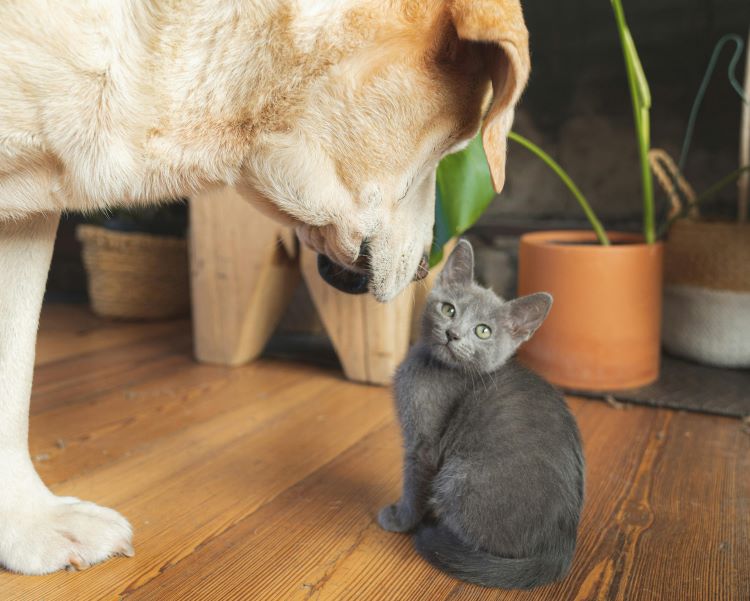Ready to help treat your pet to a healthy life?
Are Dogs or Cats More Popular as Pets in 2025?
By : Brianna Gunter | Published May 13, 2025

When you have a dog or cat (or both!) in the family, it can be easy to feel like most other households have similar pet demographics. Perhaps you’ve even found local meetup groups and plenty of online social posts that support this. But when it comes to actual pet ownership, the numbers may tell a different story.
So, which is the more popular household pet, dogs or cats?
Depending on where you look, most sources say there are more pet dogs in the world than there are cats. However, the answer to which pet is more popular is not as straightforward as it seems. Let’s take a closer look, shall we?
What the statistics say about pet ownership
Despite dogs often being touted as the more popular animal companion, the real numbers of cat and dog ownership in the world are actually unknown. Veterinary and local jurisdiction registration practices vary greatly by location, and pets are not always taken into account on census reports. Additionally, any dog and cat data that is collected often isn’t updated annually. What we do know, however, is that available dog ownership counts from 2018 through 2024 estimate anywhere from 700 million to 1 billion dogs globally.
Cat data is meanwhile even trickier to nail down. Many online results cite “around 600 million” pet cats in existence, but it’s unclear where this figure comes from. Not only are cats less likely to be registered, but statistics further vary depending on if feral populations are taken into account. Compiled estimates from 2023 and 2024 suggest the total global cat population may exceed 1 billion, but this includes feral cats as well as large wild cats — less than half are pet cats living with humans.
Pet popularity in the United States
According to the 2024 American Veterinary Medical Association (AVMA) Pet Ownership and Demographic survey, dogs reign as the most popular pet among American households. After taking a slight dip in 2023, our canine companions have regained their footing and hit a new high of 89.7 million in 2024. This is reflective of a steady overall rise over the past two decades, with dogs up from 52.9 million in 1996.
The number of cats has meanwhile undergone more of a rollercoaster ride, growing from about 59.8 million in 1996 to 81.7 million in 2006, then hitting 73.8 million in 2024. To put that into perspective, that’s about 37% of US households with cats and a little over 50% with dogs.
Looking at pets on the state level, dogs are arguably most popular in Arkansas, where dog owners make up 48% of the population. And, as the national numbers already show, they are also the most popular pet in most states. Cats are meanwhile the most popular pets in only nine states, with Vermont leading in 2025 with about 45% of its residents having cats.
What about Canada?
Unlike the US, cats have their canine counterparts slightly beat in popularity in Canada. A 2024 nationwide survey found around 8.9 million cats at home in Canadian households, compared to 8.3 million dogs.
Looking at individual provinces, however, cats aren’t the most popular pets across the board. As of 2025, cats are most popular in Quebec, with 67% of the population being cat owners compared to 48% dog owners. Meanwhile in Ontario and in the Atlantic provinces, it’s an even split between dogs and cats. In all other provinces, dogs rule in popularity.
Impressively, pets in general appear to be more popular in Canada than the US. Whereas only around 66% of US households have pets, around 80% of Canadian households do.

Factors that affect changes in dog and cat ownership
Although both dog and cat ownership have been on the rise in recent decades, there are various socioeconomic factors affecting how people feel about pets and their desire to adopt a furry family member. Income level plays one of the most important roles, as pets require financial resources for their health and general upkeep. The type of pet people choose may therefore be influenced by that pet’s perceived financial cost.
Urban versus rural living has also been found to impact pet ownership; rural areas often have more space and fewer housing restrictions. Demographics also matter — families with children, for example, have traditionally been more likely to own pets, especially dogs. Additionally, housing policies, such as rental restrictions, and lifestyle factors like work hours and travel frequency, affect one’s ability and willingness to care for pets responsibly as well as pet species preferences.
It should also go without saying that cultural attitudes toward animals and pet ownership vary globally. Some cultures are simply more likely to view dogs and cats as valued companions, while some may value cats over dogs, or vice versa.
Protect dogs and cats against surprise veterinary costs
Whether you prefer cats or dogs, or you love them both equally, our furry friends are worth protecting. All pets are at risk of accidents and surprise health conditions throughout their lifetime, and these situations can be tough to budget for. But while you can’t fully plan ahead, you can take preventative steps now.
Talk with your veterinarian about your dog or cat’s particular risks for their breed, species, and lifestyle, and be sure to keep pets on a healthy diet with daily exercise. You’ll also want to consider pet health insurance to help protect against those veterinary surprises.
Learn more about the benefits of pet insurance today!
